ICP-OES Analysis: Inductively Coupled Plasma Optical Emission Spectroscopy (ICP-OES) is one of the most important methods for identifying elements by examining their emission spectra in the visible and ultraviolet wavelength ranges. This method requires a high-power, highly uniform excitation source, which has been achieved with the advancement of plasma sources. ICP-OES is a destructive technique where the sample solution is atomized and excited under plasma conditions. The emission resulting from the excitation of all elements in the sample is compared with the emission patterns of standard samples in the visible and ultraviolet ranges, allowing for the identification and quantification of each element.
GC Analysis: Gas Chromatography (GC) is a separation technique used for analyzing volatile compounds. In this method, the sample components are dissolved in a solvent and vaporized, then carried by the mobile phase through a column. The column contains a stationary phase, which can be either solid or liquid. If the stationary phase is liquid, the technique is known as Gas-Liquid Chromatography (GLC), and if the stationary phase is solid, it is known as Gas-Solid Chromatography (GSC). The basis of separation is the distribution of the sample between the stationary and mobile phases. Notably, unlike other chromatography methods, there is no interaction between the mobile phase and the sample in GC.





